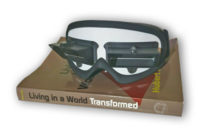Upside down goggles

Upside down goggles, also known as "invertoscopes" by Russian researchers,[1] are optical instruments that invert the image received by the retinas upside down. They are used to study human visual perception, particularly psychological process of building a visual image in the brain. Objects viewed through such a device appear upside down and mirrored. They are constructed using sets of optical right-angle prisms, concave mirrors, or a mirror plus right-angle prisms with unequal cathethus.
Purpose
[edit]Upside down goggles can be used to demonstrate human adaptation to inverted vision, and as a method of preventing motion sickness.[2] Hubert Dolezal recommended using upside down goggles for "nausea adaptation" for space travel.[3]
They can also be used to train spatial abilities and possibly cognitive functions.[Patents of devices 1]
Effect
[edit]
Under normal circumstances, an inverted image is formed on the retina of the eye. With the help of upside down goggles, the image on the retina of the observer's eyes is turned back (straightened) and thus the space around the observer looks upside down.[4]
History
[edit]George Washington designed the first upside down goggles for a psychological experiment. His device used short-focus lenses. Stratton used a one-tube, monocular device because this also reverses left and right and he wished to set up an experiment without distortion of depth perception.[5]
In 1931 Theodor Erismann and Ivo Kohler conducted a series of experiments using mirror-prismatic upside down goggles employing only one mirror.[6]
After experimenting since 1984, in 1991 Hubert Dolezal procured a US patent for comfortable light upside down goggles.[Patents of devices 2]
Modern upside down goggles consist of two prisms fixed onto a comfortable ski mask-like base.
Notes
[edit]References
[edit]- ^ Logvinenko, A.D. (1974). Perception under the conditions of inversion of the visual field. Dissertation. Russia: MSU. pp. 5–67.
- ^ Khotinskiy, D.A. (2017). "Vestibulo-ocular stage of human adaptation to inversion or reversion of the field of view as method of preventing motion sickness. pp 64" (PDF). Archived from the original (PDF) on November 30, 2019. Alt URL
- ^ Hubert, Dolezal (1982). Living in a World Transformed. Chicago Illinois: Department of Psychology Northeastern Illinois University Chicago. p. 314. ISBN 978-1-932846-02-7.
- ^ Logvinenko, A.D. (1974). "Adaptation to inverting vision". Questions of Psychology. 12: 101.
- ^ Stratton, George (1896). "Some preliminary experiments on vision without inversion of the retinal image". APA PsycNET: 1.
- ^ Sachse, P.; Beermann, U.; Martini, M.; Maran, T.; Domeier, M.; Furtner, M. R. (2017). ""The world is upside down" - The Innsbruck Goggle Experiments of Theodor Ehrisman (1883-1961) and Ivo Kohler (1915-1985)". Cortex; A Journal Devoted to the Study of the Nervous System and Behavior. 92: 222–232. doi:10.1016/j.cortex.2017.04.014. PMID 28521154. S2CID 4636264.
